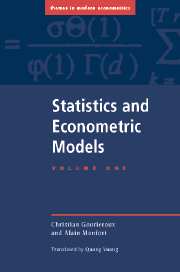Book contents
- Frontmatter
- Contents
- Preface
- 1 Models
- 2 Statistical Problems and Decision Theory
- 3 Statistical Information: Classical Approach
- 4 Bayesian Interpretations of Sufficiency, Ancillarity, and Identification
- 5 Elements of Estimation Theory
- 6 Unbiased Estimation
- 7 Maximum Likelihood Estimation
- 8 M-Estimation
- 9 Methods of Moments and Their Generalizations
- 10 Estimation Under Equality Constraints
- 11 Prediction
- 12 Bayesian Estimation
- 13 Numerical Procedures
- Appendix tables
- Index
Preface
Published online by Cambridge University Press: 04 August 2010
- Frontmatter
- Contents
- Preface
- 1 Models
- 2 Statistical Problems and Decision Theory
- 3 Statistical Information: Classical Approach
- 4 Bayesian Interpretations of Sufficiency, Ancillarity, and Identification
- 5 Elements of Estimation Theory
- 6 Unbiased Estimation
- 7 Maximum Likelihood Estimation
- 8 M-Estimation
- 9 Methods of Moments and Their Generalizations
- 10 Estimation Under Equality Constraints
- 11 Prediction
- 12 Bayesian Estimation
- 13 Numerical Procedures
- Appendix tables
- Index
Summary
The present textbook was motivated by two principles drawn from our teaching experience. First, the application of statistical methods to economic modelling has led to the development of some concepts and tools that are frequently ignored in traditional statistical textbooks. Second, it is possible to introduce these various tools, including the most sophisticated ones, without having recourse to mathematical or probabilistic concepts that are too advanced. Thus the main goal of this book is to introduce these statistical methods by taking into account the specificity of economic modelling and by avoiding a too abstract presentation.
Our first principle has various consequences. Though we discuss problems, concepts, and methods of mathematical statistics in detail, we rely on examples that essentially come from economic situations. Moreover, we analyse the characteristics and contributions of economic methods from a statistical point of view. This leads to some developments in model building but also in concepts and methods. With respect to model building, we address issues such as modelling disequilibrium, agents’ expectations, dynamic phenomena, etc. On conceptual grounds, we consider issued such as identification, coherency, exogeneity, causality, simultaneity, latent models, structural forms, reduced forms, residuals, generalized residuals, mixed hypotheses, etc. It is, however, in the field of methods that the economic specificity brings the most important consequences. For instance, this leads to focus on predictions problems, maximum likelihood or pseudo conditional maximum likelihood type estimation methods, M-estimators, moment type estimators, bayesian and recursive methods, specification tests, nonnested tests, model selection criteria, etc.
Our second principle concerns our presentation. In general, we have tried to avoid proofs that are too technical.
- Type
- Chapter
- Information
- Statistics and Econometric Models , pp. xv - xviiiPublisher: Cambridge University PressPrint publication year: 1995



